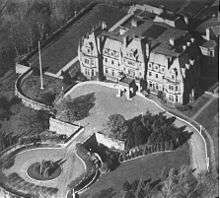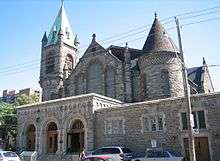Henry Langley (architect)
| Henry Langley | |
|---|---|
_1836_-_1907.jpg) | |
| Born |
26 November 1836 Toronto, Ontario, Canada |
| Died |
1907 Toronto, Ontario, Canada |
| Nationality | Canadian |
| Alma mater | Toronto Academy |
| Occupation | Architect |
| Buildings | Government House |
Henry Langley (26 November 1836 – 1907) was a Canadian architect based in Toronto. He was active from 1854 to 1907. Among the first architects born and trained in Canada, he was a founding members of the Royal Canadian Academy of Arts in 1880 and was instrumental in establishing the Ontario Association of Architects in 1889. A conservative in architectural design, he is primarily known for designing numerous churches in the Toronto area, although he designed many secular buildings as well including residential, commercial and public buildings. Langley designed 70 churches throughout Ontario.[1] He was the first chair of the Department of Architecture at the University of Toronto, where he taught during the 1880s and 1890s.[2]
Life and career
Langley's parents, William Langley and Esther Anderson, emigrated to Canada from Ireland in 1832. Born in Toronto, Langley received his general education from the Toronto Academy[3] where part of his training included studying the principles of drawing. In early 1854 he became apprenticed to Scottish architect William Hay,[3] who was a specialist in gothic architecture.[4] During his seven-year apprenticeship, he worked with Hay on some of the oldest buildings and structures in Toronto, including St. Basil's Church, Toronto (1855–1856), two of the original buildings at the University of St. Michael's College (1856), Yorkville Town Hall (1859-1860) and the Oaklands at De La Salle College (1860) among other structures.
After Hay's departure from Toronto in 1861, Langley was invited in 1862 by Hay's partner, Thomas Gundry, to become his new partner. He accepted and quickly became the firm's primary designer with Gundry shouldering most of the business side of the company. His most important project during these years was the Government House (1857–1859). In 1869 Gundry died, after which Langley spent the next four years working alone. However, he was assisted during those years by two talented apprentices who later became well known architects in Toronto: Frank Darling and his nephew Edmund Burke.[5][6]
With the success of the firm, Langley brought in Burke and his brother, the builder Edward Langley, as partners in 1873. The company was in high demand and greatly increased its staff over the next several years. His brother left a decade later and Burke departed in 1894. His son, architect Charles Edward Langley, worked with him during the last 14 years of his life. Charles was the first person to graduate from the Department of Architecture at the University of Toronto on 3 May 1892.
Langley died in Toronto in 1907 and is interred at the Toronto Necropolis. He notably designed that cemetery's chapel.
Selected works
| Building | Year Completed | Builder | Style | Source | Location | Image |
|---|---|---|---|---|---|---|
| St. Peter's Anglican Church, Toronto | 1864–1866 | Gundry and (Henry) Langley | Gothic Revival | 15 | 188 Carlton Street at Sherborne Street, Toronto, Ontario |  |
| St. Michael's Cathedral (Toronto) spire | 1865-66 | Gundry and (Henry) Langley | Gothic Revival | Toronto, Ontario | .jpg) | |
| St. Basil's Church, Toronto | 1865-66 | Gundry and (Henry) Langley | Gothic Revival | Toronto, Ontario | | |
| Government House (Ontario) | 1865-6s | Gundry and (Henry) Langley | Gothic Revival | Toronto, Ontario |  | |
| St. Stephen-in-the-Fields Anglican Church, Parkdale Deanery | 1865-6 | Henry Langley | Gothic Revival | 15 | Bathurst Street and College Avenue, Toronto, Ontario | |
| Metropolitan United Church | 1872 | Henry Langley | French Gothic Revival | W | Church Street and Queen Street East, Toronto, Ontario | |
| Toronto Necropolis Chapel | 1874 | Henry Langley | Gothic Revival | 15 | Winchester Street and Sumach Street, Toronto, Ontario | |
| St. Luke's United Church | 1874 | Henry Langley and Edmund Burke | Romanesque Revival | 15 | Sherborne Street and Carlton Street, Toronto, Ontario |  |
| St. Andrew's Evangelical Lutheran Church | 1878 | Henry Langley & Edmund Burke | Gothic Revival | 15 | 383 Jarvis Street, Toronto, Ontario | |
| Jarvis Street Baptist Church | 1878 | Henry Langley & Edmund Burke | Gothic Revival | Jarvis Street, Toronto, Ontario |  | |
| St. Mark's Anglican Church, Parkdale | 1881 | Henry Langley, Henry Langley and Edmund Burke (Design) | Gothic Revival | 201 Cowan Ave, Toronto, Ontario | | |
| McMaster Hall | 1881 | Henry Langley, Henry Langley and Edmund Burke (Design) | Romanesque Revival | 2 | 273 Bloor Street West, Toronto, Ontario | |
| Beverley Street Baptist Church | 1886 | Henry Langley & Edmund Burke | Gothic Revival | 6 | 72 Beverley Street, Toronto, Ontario | .jpg) |
| Trinity-St. Paul's United Church | 1887–1889 | Henry Langley and Edmund Burke | Gothic Revival | 15 | Bloor Street west of Spadina Avenue, Toronto, Ontario | |
Gundry & Langley (1862-1869)
- St. Peter’s Anglican Church, 1864–65
- Alexander Street Baptist Church, 1866, Demolished
- St. Patrick’s Roman Catholic Church, 1869–70, now Our Lady of Mount Carmel Catholic Church
Langley (1869-1874)
- McGill Square Church, 1870–72, now Metropolitan United Church
- Parliament Street Methodist Church, 1871, Demolished
- Toronto Necropolis Chapel, 1872
Langley, Langley & Burke (1874-1884)
Henry Langley, Edward Langley & Edmund Burke
- Jarvis Street Baptist Church, 1874–75
- The Cathedral Church of St. James, spire, 1874
- Sherbourne Street Methodist Church, 1876, now St. Luke’s United Church
- St. Andrew’s Presbyterian Church, 1877–78, now St. Andrew’s Evangelical Lutheran Church
- Elm Street Methodist Church, 1877, Demolished
- Little Trinity Anglican Church, addition, 1878
- St. Mark’s Anglican Church, 1881
Langley & Burke (1884-1894)
Henry Langley & Edmund Burke
- Beverley Street Baptist Church, 1886, now Chinese Baptist Church
- Trinity Methodist Church, 1887–89, now Trinity St. Paul’s United Church
- College Street Baptist Church, 1888, now Portuguese Seventh-Day Adventist Church
- Dunn Avenue Methodist Church, 1889, Demolished
- Walmer Road Baptist Church, 1889–92
Langley & Langley (1894-1907)
Henry Langley & Charles Edward Langley
- Memorial Baptist Church, 1897
References
- ↑ http://www.heritagefdn.on.ca/userfiles/HTML/nts_1_7536_1.html Ontario Heritage Trust Henry Langley 1836-1907
- ↑ "Henry Langley". Dictionary of Canadian Biography Online.
- 1 2 Carr, Angela (1995). Toronto architect Edmund Burke: redefining Canadian architecture. McGill-Queen's Press. p. 7. ISBN 978-0-7735-1217-7.
- ↑ "Henry Langley, 1836 -1907 RCA". Toronto Public Library.
- ↑ Carr 6.
- ↑ Crossman, Kelly (1987). Architecture in transition: from art to practice, 1885-1906. McGill-Queen's Press. p. 72. ISBN 978-0-7735-0604-6.
| Wikimedia Commons has media related to Henry Langley (architect). |
External links
- Architects of Our City, Henry Langley, at Heritage Oshawa
- Biography of Henry Langley, at Dictionary of Canadian Biography